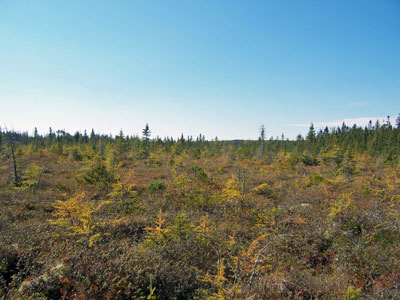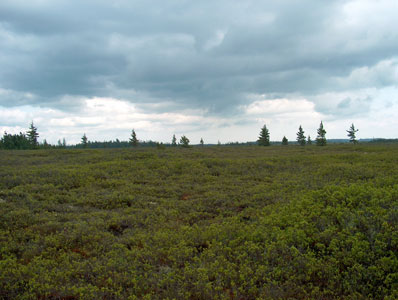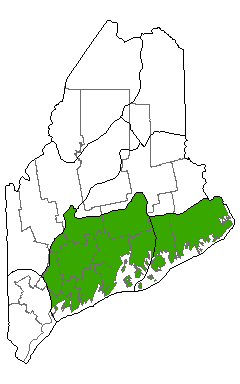DACF Home → Bureaus & Programs → Maine Natural Areas Program → Communities, Plants, and Animals → Natural Community Fact Sheets → Maritime Huckleberry Bog
Printer Friendly Fact Sheet - 800 KB pdf (Get a free copy of Adobe Acrobat Reader)
Maritime Huckleberry Bog
Scientific Name: Huckleberry - Crowberry Bog; State Rank: S3

- Community Description
- Soil and Site Characteristics
- Diagnostics
- Similar Types
- Conservation, Wildlife and Management Considerations
- Distribution
- Characteristic Plants
- Associated Rare Plants
- Associated Rare Animals
- Examples on Conservation Lands You Can Visit
Community Description: This peatland type is characterized by low (usually < 60 cm) heath shrubs, such as sheep laurel and leatherleaf, as the dominant layer. Dwarf huckleberry is typically prominent. Black crowberry and/or deer-hair sedge are also present, though not necessarily abundant. In far Downeast examples, black crowberry may entirely replace dwarf huckleberry. Small islands of stunted black spruce may be scattered among the shrubs. Pitcher plants, sundews, bog goldenrod, and other typical bog herbs are mixed in with the shrubs; herb cover is usually <40%. Deer-hair sedge may be locally dominant. A dense layer of peat mosses underlies the plants. Back to top.
Soil and Site Characteristics: These are coastal or near coastal peatlands, either in raised bogs or in weakly minerotrophic areas transitional to true bogs. They are saturated during the growing season and typically highly acidic (pH < 5.0, occasionally slightly higher). Back to top.

Diagnostics: Dwarf shrub peatland vegetation is characterized by dwarf huckleberry and/or black crowberry together forming >20% cover. Sheep laurel and leatherleaf are usually present but at lower cover than in other dwarf-shrub peatland types. Back to top.
Similar Types: Dwarf Shrub Bog and Leatherleaf Bog communities are similarly found in true bogs and dominated by heath shrubs. They may be contiguous with this type in some bogs. A few of these sites in south-coastal Maine have dwarf huckleberry even though they are not Maritime Huckleberry Bogs. The dominance of dwarf huckleberry with either crowberry or deer-hair sedge distinguishes Maritime Huckleberry Bogs from other bog vegetation types. Back to top.
Conservation, Wildlife and Management Considerations: This community type is not widely distributed, but has been subject to few threats to date. Slow vegetation growth rates, due to the nutrient-poor conditions, mean slow recovery from physical disturbances, such as recreational trail use. If disturbance, such as foot traffic, is a necessity, traversing during frozen conditions or using boardwalks can minimize impacts. Peat harvesting could threaten some sites. Changes to bog hydrology, through impoundment or draining, could lead to vegetation changes. Several occurrences are on public lands or private conservation lands.
The rare crowberry blue butterfly is restricted to coastal heaths in east-coastal Maine. It uses black crowberry as a larval host plant. Several uncommon dragonfly species may be found in examples of this community where bog pools occur, including the zigzag darner, subarctic darner, and incurvate emerald. Back to top.
Distribution: Most typical of Downeast Maine from Penobscot Bay eastward. Always within 15 miles of the shore (Laurentian Mixed Forest Province). Extends east into the Canadian Maritimes. Landscape Pattern: Small Patch. Back to top.


Characteristic Plants: These plants are frequently found in this community type. Those with an asterisk are often diagnostic of this community.
- Sapling/shrub
- Black spruce
- Dwarf Shrub
- Black crowberry*
- Dwarf huckleberry*
- Labrador tea*
- Leatherleaf*
- Pale laurel
- Sheep laurel*
- Small cranberry
- Herb
- Bog goldenrod
- Deer-hair sedge*
- Pitcher plant
- Round-leaved sundew
- Bryoid
- Cladonia lichen*
- Reindeer lichen*
- Sphagnum fuscum*
- Crowberry blue
Examples on Conservation Lands You Can Visit
| Example | County |
|---|---|
| Acadia National Park | Hancock Co. |
| Great Wass Island Preserve | Washington Co. |
| Quoddy Head State Park | Washington Co. |